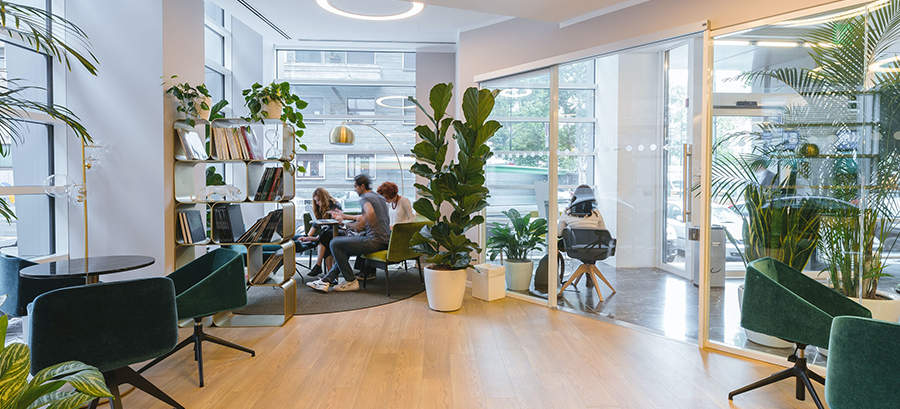How the Early Arrival of the Future of Work is Foreshadowing for the Workplace of Tomorrow
The future of work was supposed to be something that was always coming but never arrived. Thought leaders and experts would talk about the ‘future of work’ as a concept – nothing more than a device to help us better prepare to leap into the next chapter of our life and business. And yet in March of 2020, with what seems like little warning, the future of work arrived, immediately changing the game for millions overnight. With self-isolation and physical distancing guidelines setup across America and around the world, office doors have been locked, and the 2017 video of the BBC dad whose daughter famously marched into the frame is now more relatable than ever.
Well, we’ve finally managed to shave some time off the morning commute, which now involves walking from our kitchen to the once neglected spare bedroom/storage closet/home office. With distractions abound, be it kids, family, or your attention-seeking dachshund, we’ve all had to adjust. Apptopia reported that Zoom now has 15.3 million daily users (about twice the population of LA, NYC, Boston, San Francisco, Dallas and Phoenix, combined). This nearly quintuples the number of users on the platform this time last year. Video chat is skyrocketing and in-person connection falling off a steep cliff, like Mufasa in Lion King.
Here’s what the last few weeks have taught us about the workplace of tomorrow:
1. Work is measured by results, not time
Gone are the days of the 9 to 5 workplace. Think of the single mom that is dressing, feeding, and organizing her kids, while trying to take care of herself and her workload. One of her children isn’t getting the math concept and she has just jumped in to help. The soup on the stove is boiling over and she’s nowhere near the computer at 11:30AM. After a hectic day, she’s got the kids to bed and the last load of laundry in before heading back to the computer to finish the report before the virtual meeting tomorrow morning. It didn’t matter whether the work got done at 2:00PM or 10:00PM, it just mattered that it got done, and was done well.
2. Build trust by monitoring progress
If an employee is working on a report in self-isolation and nobody is around to witness it, did it even happen? Yes, just like the tree in the forest it made a sound and you just missed it. With a lot of working professionals now forced to be working from home, regular team huddles and check-in calls can help leaders track progress and more importantly help employees feel recognized and valued. Nobody likes a helicopter manager, but when it comes to keeping a remote team empowered remember the 3 A’s: Be aware, available and approachable. Without these, it’s hard to track projects and maintain relationships. In order to continue building trust, focus on tracking progress. The workplace of tomorrow will see remote work as a common practice, not an exception, and will be able to monitor progress and build trust as a result.
3. Work life integration will be even more prominent
Are they wearing pants? We’d like to think so but can’t be too sure. What we’re realizing is that people are people and the idea of perfection is gone. Good riddance. The past weeks have forced us to take our masks of perfection off. Without time to prepare for the shift from office to home, we’ve all seen messy homes and apartments, kids running around in the background, unidentifiable noises that are frustrating but forgiving, and the odd stain on a shirt. The forgivingness we’re seeing today will help shape the workplace of tomorrow and allow people to do their best when they can, however they can. Because of this, work and life will be even more blended. On our team calls, we’ll be introduced to pets, kids, and significant others bringing even more humanity to the new office. This better understanding of each other’s lives will become a foundation for even better empathy and community being built in the future as we won’t just be the professionals we are; we’ll be a member of a family, owner of a pet, and a human as well.
4. Virtual meetings and conferences will increase
Finally, we’ll see that because more people are able to work remotely, flexibly, and on their own time, that virtual events and connection with people will be appreciated more than we’ve seen before. We’ll see a variety of smaller virtual team events, interdepartmental meetings, and industry expos added to calendars. This growth in the virtual events sector will allow people the opportunity to interact and connect with the people they’ve been working with on a regular basis, share best practices, and strengthen relationships. These virtual events will be partially educational, but largely an opportunity to celebrate, connect, and share.
If there is something we’ve learned from the past few weeks, it is that these unprecedented times have accelerated what we thought the future of work was going to look like. We’ve learned that we can trust people, that they can get their work done from anywhere, and that in-person connection and community is craved. If one thing is clear, it’s that we’re well on our way to a more vibrant, inclusive and connected workplace culture.
Do you have any thoughts on this article? Send me a note at etermuende@gmail.com or fill out the contact form.
More posts
Given the Pandemic, There is Currently Something More Important Than Our Company ‘Why’
Over the past months, the pandemic has dominated the headlines. Greta Thunberg and the acute…
Most of us can vividly recall the nervous feeling right before our teachers would take…
More Than Just an Office: The Potential of the Workplace of Today
“I just want things to go back to normal.” Perhaps you have either heard or…



